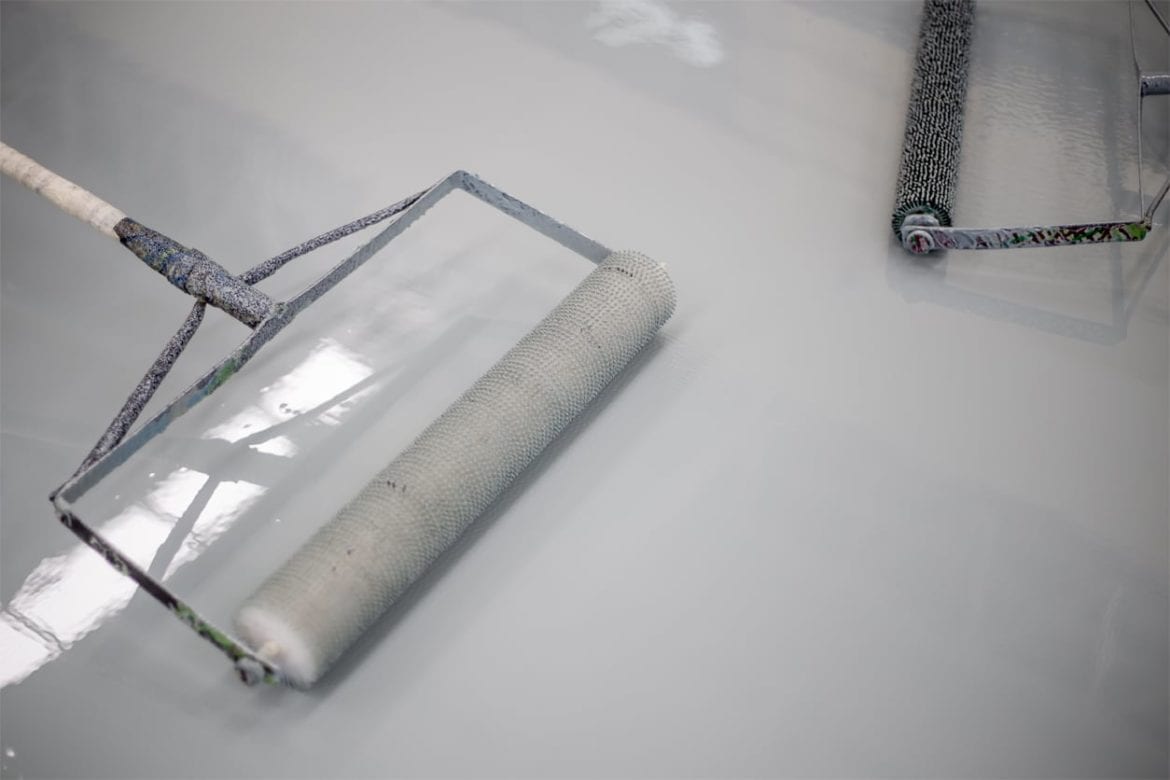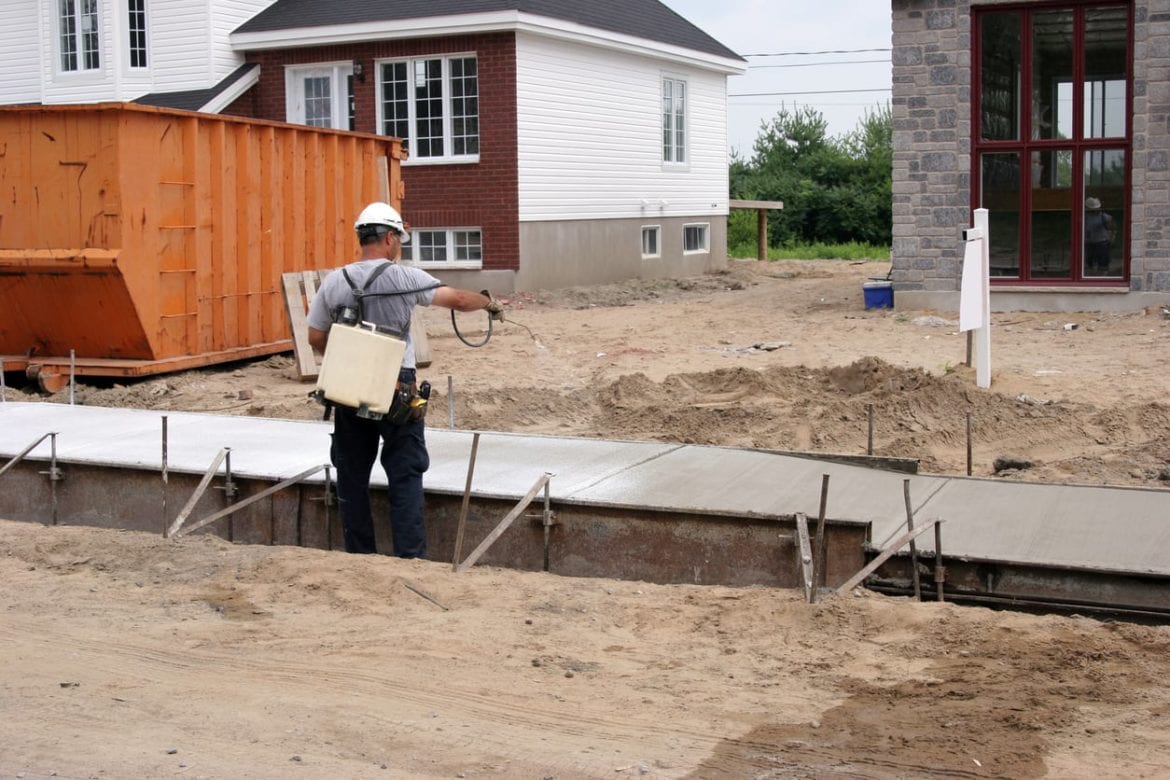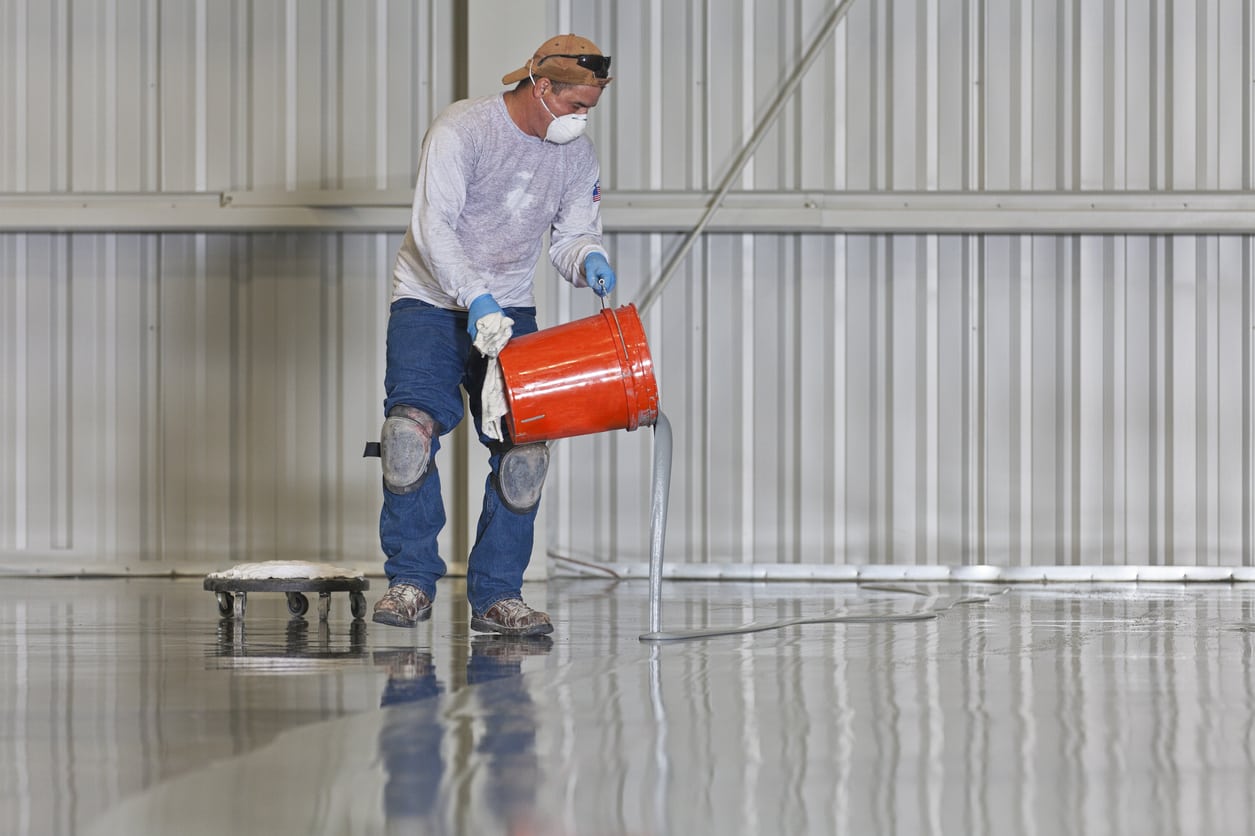Polyaspartics are fast becoming a veritable wonder product on the concrete sealer market today. These products are relatively new derivatives of the traditional aliphatic urethanes that have been around for a lot longer. Aliphatic urethanes are typically used as topcoats that feature incredibly strong levels of resistance to the most extreme weather conditions, water exposure, heat, abrasions, and other such threats to concrete. While urethanes are typically used as the topcoats in concert with epoxy base layers, they can also stand on their own.
Polyaspartics are newer product that are similar to urethanes. The biggest difference between a polyaspartic concrete sealer and a traditional urethane is that the polyaspartics feature incredibly short dry times. They can be applied to the large floor of a retail store, for instance, only to dry completely overnight and be ready for the store to open for full service the next day.
However, the biggest drawback to polyaspartics is their short pot-life. The pot-life is the technical jargon term for the amount of time before being applied that a solution can last without being ruined. That is to say, once you mix a polyaspartic, it all has to be applied within a certain (short) period of time before it becomes unusable. A short pot-life is typical for a product that cures rapidly, as do polyaspartics. And, while this can be an inconvenience, it is not the end of the world, as there are proven ways to work around the limitation.
A general rule of thumb is that polyaspartics with a lower solids content will have a longer pot-life. Polyaspartics typically have a solids content between 70% to 100%; therefore, a product with a solids content of 70% will have a longer pot-life than a product with a 100% solids content. Another factor that makes the pot-life shorter is the amount of moisture, typically in the form of humidity, that the mixed polyaspartic is exposed to – the more moisture/humidity, the shorter the pot-life.
In order to extend the effectiveness of the polyaspartic, it is best to mix small amounts of the product more often in order to work around the short pot-life. As polyaspartics need to be mixed together before use, it is best to mix as you go, applying the polyaspartic between mixing breaks (even if this means mixing more often), in order to maximize the potential.
The Eagle Seal Satin Seal concrete sealer is a non-yellowing acrylic sealer that offers to provide an appropriate level of protection for all types of concrete. However, the Satin Seal is only an acrylic sealer, according to information found on its SDS sheets. Therefore, it is not an appropriate choice for any and every type of concrete; rather, it is appropriate for certain projects that require a surface-level sealer.
The Satin Seal will bond to the concrete’s surface, featuring large particles of acrylic sealant that will not penetrate past the tiny surface pores natural to all concrete. While a penetrating sealer will, of course, penetrate to chemically react within the concrete to provide protection, a surface-level sealer, like the Satin Seal, remains on the surface of the concrete to function like a raincoat; It will repel up to a certain level of water and salts. We would recommend the Satin Seal for delicate types of decorative concrete, stamped concrete and pavers.
If you are looking for a decorative sealer with a satin sheen it would be best to use this product. Just remember that decorative sealers need to be reapplied every year or so, more frequent than penetrating sealers which can last upwards of 5 years.
Concrete is a delicate material. That is not to say that it is not strong – it is, in fact, one of the strongest man-made materials on Earth, and it can be reinforced with steel rebar to make it even stronger. It is also incredibly long-lasting, and has the potential to last tens of thousands of years, far longer than generations of human life. However, it is delicate in its creation, which needs to be fine-tuned to achieve the maximum potential strength of the future concrete.
Concrete is created through a precise mixing process of water, Portland cement, and some sort of aggregate, which can be sand and gravel. While many people use the term “cement” to refer to concrete, this is actually misleading as it is merely an ingredient in concrete. The concrete is mixed thoroughly with the proper proportions of each ingredient, before being poured soon thereafter.
After the pouring process, however, comes the most delicate part of the creation of concrete. Once concrete has been mixed and poured, is has to sit for a period of time before it has fully hardened. Without a constant level of temperature and moisture, the concrete will either crack from too much moisture, or dry out and crumble. These problems can be especially bad in the future, which is why many concrete professionals refer to a failed curing process has harming the concrete’s potential strength.
Most curing periods last around thirty days, after which the concrete can be walked on, used, and uncovered without any harm to its potential strength. It is also for this reason that you cannot typically apply a concrete sealer before the thirty day curing period. If you apply a concrete sealer to a concrete slab that has not fully cured, then you risk ruining and harming the concrete’s potential future strength. However, if you apply the sealer after the curing process has been completed, then your concrete will be perfectly strong and protected throughout its lifespan.
Cryli-Tek 5500 is a pricey acrylic sealer, but it is also the top choice of professional contractors and expert homeowners. Ghostshield markets its Cryli-Tek 5500 as a one-coat sealer — which should theoretically save money by cutting the amount of sealer you need in half compared to other acrylic sealers on the market. After testing out Cryli-Tek 5500 for ourselves it does live up to its other major marketing claims: It dries in 3 hours with little odor and Cryli-Tek 5500 is a low-volatile organic compound (VOC) sealer, meaning it has low levels of the chemicals in sealers that are linked to respiratory and other health problems.
We love that it is water based and still leaves a slight matte sheen enhancing colored and stamped concrete. We also found Cryli-Tek 5500 breathable, non-yellowing, and highly scratch and peel proof. Remember when looking for a decorative sealer to look for a breathable one to avoid problems down the line. Above all, professional contractors and do-it-yourselfers love Cryli-Tek 5500’s beautiful finished matte look.
However, Cryli-Tek 5500 is pricier than other acrylic sealers in its class. But since it lasts longer than other acrylics, we found the price justifiable. Cryli-Tek 5500 is available at HomeDepot.com and independent retailers and online at Concrete Sealer Supply.
The MasterProtect H 400, formerly the Enviroseal 40, manufactured by the BASF chemical company, is a clear, water-based silane sealer. Silane sealers are a type of penetrating sealer that features small particles of sealant that penetrate past the surface of the concrete to lock out water and salts.
The MasterProtect H 400 is a reputable silane on the market. The MasterProtect H 400 is an excellent source of protection for chlorides, freeze/thaw cycles, and other such potential threats. Because of this and other characteristics of its chemical formula, the MasterProtect H 400 is a preferred sealer for certain environments that need protection from high traffic, whether from machinery or from humans. The smallest available quantity is a 5 gallon bucket so it is typically used in commercial applications.
The MasterProtect H 400 is also a great choice for commercial projects because of its international appeal. As it is manufactured by BASF, you can be assured that it will perform up to the high standard required of that company. Similarly, it is marketed across the world, as facilitated by the resources of a company as large as BASF.
Have you ever wondered how the concrete floors that make up most large commercial buildings, retail or otherwise, remain so clean? They rarely exhibit signs of water or chemical spillage, as well as cracking or similar such things that mar the visual appeal. These floors are solid, clean, smooth, and never show the degradation that can affect your own concrete in your home or building.
The secret to the protection is not even really a secret. Concrete sealers are what give the concrete floors of commercial buildings their long-lasting strength and visually unblemished surfaces. With the incredible amount of traffic from feet, machinery, products, and pallets, the concrete floors would soon deteriorate under normal circumstances had they not been protected with a concrete sealer.
The best concrete sealer for large commercial floors would be an aliphatic urethane. Aliphatic urethanes are a type of topical concrete sealer whose large particles of sealant preclude the concrete sealing solution from passing into the concrete. Instead, the aliphatic urethane particles will puddle on the surface of the concrete to be spread out evenly during the application process if you are using a broom. If you elect to use a light pump sprayer, the application is even easier, though the result will be the same.
Aliphatic urethanes are concrete sealants that feature remarkable levels of protection against the most extreme conditions concrete could be subjected to. They offer excellent resistance to heat, UV radiation, water damage, chemical spills, abrasions, discoloration, and other such potential threats to the structural and visual integrity of the concrete. For it is true that the visual appeal of a commercial building’s floors is just as important as the structural integrity of said floors – shoppers do not want to be wandering around buildings whose floors are cracked, stained, and dingy.
Aliphatic urethanes are the best solution for the floors of a commercial building. And, if you have a project that needs to be completed overnight, before business begins the next day, you need to choose a polyaspartic concrete sealer. Polyaspartics are the wonder materials of the concrete sealing industry, featuring all of the same benefits of aliphatic urethanes with the added bonus of an exceptionally fast dry time – simply apply the polyaspartic at night and it will have completely dried and bonded to the concrete floor by the morning. Whichever product you opt for, you will be satisfied with the results.
Our Take:
Excellent Aliphatic Urethanes: Sherwin William’s Corothane, Urethane 645 and ArmourShield XP
Excellent Polyaspartics: Flexmar’s Polyaspartic, Rhino Pro Flooring’s Polyaspartic, and HP Spartacote’s Polyaspartic






